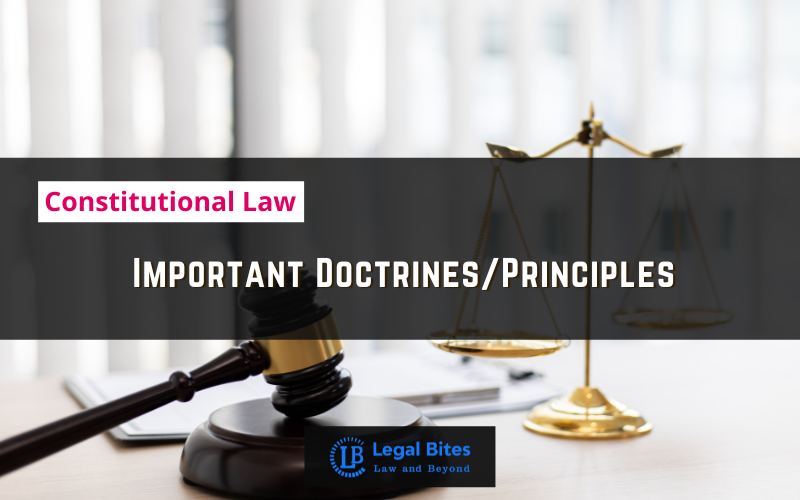Important Doctrines/Principles under Constitutional Law
Read important Doctrines/Principles under Constitutional Law only on Legal Bites.

This article titled ‘Important Doctrines/Principles under Constitutional Law’ deals with various important doctrines and principles used in Constitutional Law, along with brief descriptions.
Important Doctrines/Principles under Constitutional Law
1. Doctrine of Basic Structure
The basic structure doctrine is an Indian judicial principle that the Constitution of India has certain basic features that cannot be altered or destroyed through amendments by the parliament.
This doctrine was first expressed in Kesavananda Bharati v. State of Kerala.
2. Doctrine of Harmonious Construction
“Whenever there is a case of conflict between two or more Statutes or between two or more parts or provisions of a Statute, then the Statute has to be interpreted upon harmonious construction.
3. Doctrine of Eclipse
The doctrine states that if any law becomes contradictory to fundamental rights, then it does not permanently die but becomes inactive. As soon as that fundamental right is omitted from the Constitution, the inactive law becomes revived. When a court strikes a part of the law, it becomes unenforceable. Read more about the Doctrine of Eclipse here.
4. Doctrine of Pith and Substance
The Doctrine of Pith and Substance states that if the substance of legislation falls within a legislature’s lawful power, the legislation does not become unconstitutional just because it impacts an issue beyond its area of authority. Read more about the Doctrine of Pith and Substance: Applicability in the Indian Constitution.
5. Doctrine of Incidental or Ancillary Powers
The doctrine of incidental or ancillary powers indicates that if a legislative body has the power to legislate on a particular matter, then they have the power to legislate on ancillary topics related to that matter. Unless that ancillary topic is mentioned explicitly under the jurisdiction of another legislative body. Read more about Doctrine of Incidental or Ancillary Powers: Explanation with Related Case Laws.
6. Doctrine of Colourable Legislation
It means when a legislature does not have the power to make laws on a particular subject directly, it cannot make laws on it indirectly. Colourable legislation is one of the doctrines under the Indian Constitution. It basically means coloured legislation which is not its true colour.
7. Doctrine of Severability
The doctrine of severability means that when some particular provision of a statute offends or is against a constitutional limitation, but that provision is severable from the rest of the statute, only that offending provision will be declared void by the Court and not the entire statute.
8. Doctrine of Territorial Nexus
According to the Doctrine of Territorial Nexus, laws made by a state legislature are not applicable outside that state except when there is a sufficient nexus between the state and the object. This doctrine derives its authority from Article 245 of the Indian Constitution.
9. Doctrine of Laches
The Doctrine of Laches emanates from the principle that the Courts will not help people who sleep over their rights and helps only those who are aware and vigilant about their rights. A party is said to be guilty of laches when they come to the Court to assert their rights after a considerable delay in that respect.

